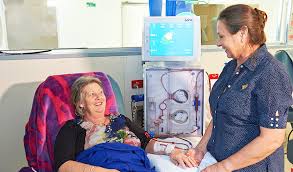Improve the Psychological and Physical Health of Dialysis Patients with Mindfulness
By John M. de Castro, Ph.D.
“We found that by engaging in mindfulness meditation, our patients have significantly decreased their anxiety, especially at the beginning of a treatment as they are connected to the dialysis machine,” – Thang Trey Ng
End-stage renal disease (ESRD) is a serious and all too common medical problem that results from a total and permanent failure of the kidneys. As a result, the body retains fluid and harmful wastes build up. Treatment, usually dialysis, is required to replace the work of the failed kidneys. Kidney dialysis uses a machine to filter harmful wastes, salt, and excess fluid from your blood. This restores the blood to a normal, healthy balance. Without dialysis or a kidney transplant the ESRD patient cannot survive It is estimated that ESRD occurs in more than 650,000 patients per year in the United States and is increasing by 5% per year. Those who live with ESRD are 1% of the U.S. Medicare population but account for 7% of the Medicare budget. Worldwide there are an estimated 2 million ESRD patients.
End-stage renal disease (ESRD) is frequently accompanied by a number of other serious diseases, such as cardiovascular disease and diabetes. Making matters worse is the fact that ESRD patients often experience psychological distress including depression. It is possible that mindfulness training may be helpful as it has been found be helpful for patients with kidney disease, to help relieve depression and improve the patients ability to effectively deal with stress.
In today’s Research News article “The effect of mindfulness program on general health of patients undergoing hemodialysis.” (See summary below or view the full text of the study at: https://www.ncbi.nlm.nih.gov/pmc/articles/PMC6009148/ ), Nejad and colleagues recruited patients with End-stage renal disease (ESRD) on dialysis and randomly assigned them to receive 8 1.5 hour weekly sessions of either a mindfulness training program or an End-stage renal disease (ESRD) education program. They were measured before and after training and 1 month later for physical health, anxiety, depression, sleep disturbance, and social problems.
They found that in comparison to baseline and to the education control group the patients who received mindfulness training had significant improvements in all measured variables including significantly lower levels of anxiety, depression, sleep disturbance, and social problems and significantly higher levels of physical health. Importantly, these improvements were still present 1 month after the completion of training. This suggests that the benefits are enduring. A strength of this study is that the control condition was an active control which eliminates many sources of bias and contamination.
The study thus indicates that mindfulness training produces substantial physical and psychological benefits for patients with End-stage renal disease (ESRD) who are on dialysis. It remains for future research to clarify exactly how mindfulness training may be helping the patients. It is possible that the improved emotion regulation or ability to cope with the physical and psychological effects of stress produced by mindfulness training were responsible for the benefits for these patients. Regardless, training in mindfulness helps relieve at least some of the burden on these patients.
So, improve the psychological and physical health of dialysis patients with mindfulness.
“Meditation could be a valuable, low-cost, nonpharmacologic intervention for reducing blood pressure and adrenaline levels in patients with chronic kidney disease” – Kurtis Pivert
CMCS – Center for Mindfulness and Contemplative Studies
This and other Contemplative Studies posts are also available on Google+ https://plus.google.com/106784388191201299496/posts and on Twitter @MindfulResearch
Study Summary
Moosavi Nejad, M., Shahgholian, N., & Samouei, R. (2018). The effect of mindfulness program on general health of patients undergoing hemodialysis. Journal of Education and Health Promotion, 7, 74. http://doi.org/10.4103/jehp.jehp_132_17
Abstract
INTRODUCTION:
Patients undergoing hemodialysis have a low level of health and mindfulness technique in mind-body medicine is used to help patients with chronic illness. Therefore, this clinical trial was conducted to determine the effect of the mindfulness program on the general health of patients undergoing treatment with hemodialysis.
METHODS:
Sixty hemodialysis patients were selected through the convenient method and randomly divided into experimental and control groups. Both groups completed demographic information questionnaire and general health questionnaire. Then, the experimental group received 8 sessions of mindfulness training and the control group received 8 sessions of education in relation to end-stage renal disease and hemodialysis. Educational sessions were performed for both groups in the second 30 min after hemodialysis for 1 h in six individual sessions and two 1.5 h group sessions. Immediately after and 1 month after the intervention, the General Health Questionnaire was completed by both groups.
RESULTS:
Analysis of the findings showed no significant differences between the mean score of general health disorder and its subscales before the intervention in to two groups (P > 0.05). Nevertheless, after intervention in the experimental group, the mean of general health disorder score decreased from 44.17 ± 12.32 to 21.9 ± 6.4 and 1 month after the intervention, the mean score of this score was 23.6 ± 6.2. The mean score of physical symptoms, anxiety and sleep disorder, social functioning deficiency, and depression were also significantly lower in the experimental group immediately after intervention and 1 month after the intervention; however, there were no significant differences between the mean of this score immediately and 1 month after the intervention. In addition, the mean score of general health disorder changes immediately and 1 month after the intervention in the experimental group was significantly more than the control group. In the control group, there was no significant difference between the mean score of general health disorder and its subscales before, immediately, and 1 month after the intervention (P > 0.05).
CONCLUSIONS:
The results of this research showed that mindfulness has been effective in reducing physical and anxiety symptoms, sleep disorder, social dysfunction, and depression symptoms. Therefore, the use of mindfulness as a complementary treatment can improve the general health level in these patients.
https://www.ncbi.nlm.nih.gov/pmc/articles/PMC6009148/



